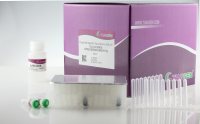Complementary DNA Libraries: An Overview
互联网
462
Complementary DNA libraries reflect gene expression at certain times for specific cells, whereas genomic DNA libraries represent all genetic information in somatic cells. The complexity of cellular organization reflects a genetic program that encodes a collection of genes and the means to use them by manufacturing proteins for cellular structures, functional activities, and reproduction of cells themselves. The essential aspect of this process is protein synthesis based on the information stored in the sequence of nucleotides that make up a gene (a transcribable segment of a DNA molecule) as the blueprint. The information is transcribed as a complementary sequence of the nucleotides (mRNA or the transcript) that carries the genetic information from the nucleus to the protein-synthesizing machinery in the cytoplasm. Then, mRNA is translated into the sequence of amino acids that make up a protein. The basis of the widely used novel strategies for the generation of cDNA libraries are base pair complementarities, reverse transcription, and polymerase chain reactions. This chapter presents some general information on the principles of, biology behind, basic protocols of, and reagents used in the generation of cDNA libraries. Hopefully, this information will help researchers overcome problems encountered in actual construction of cDNA libraries.






